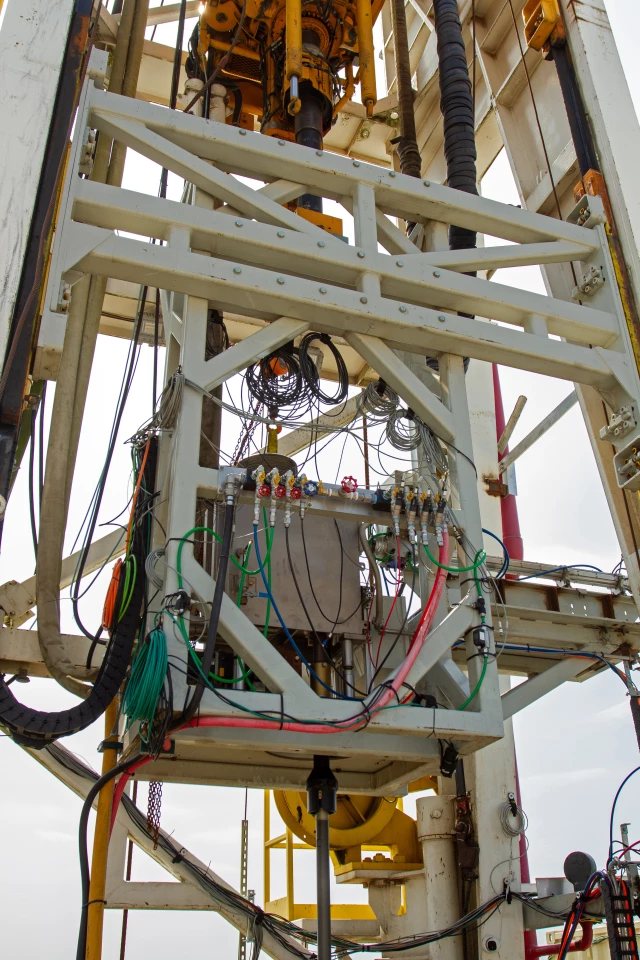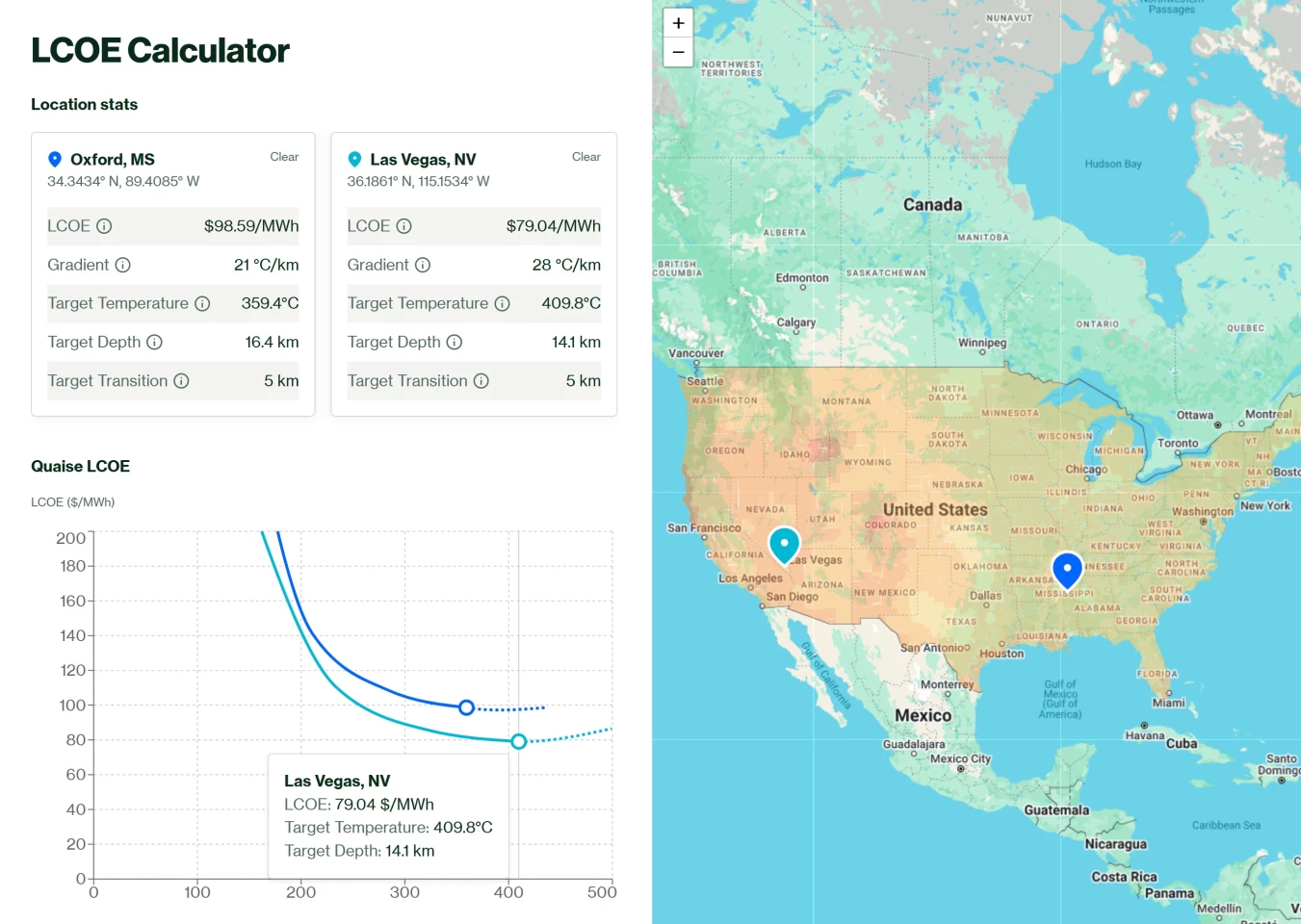On May 21, 2025, New Atlas attended a demonstration at the Nabors facility in Houston, Texas, where Quaise Energy showcased a literal groundbreaking demo of its millimeter wave drilling technology, looking to prove its dream of revolutionizing geothermal energy extraction.
Quaise was officially founded in 2018 as a spinout of MIT's Plasma Science and Fusion Center. The idea of using a gyrotron – a device that uses high-frequency millimeter waves like a microwave on steroids – to vaporize rock goes back a decade earlier to 2008 when MIT researcher Paul Woskov suggested it could be used for deep drilling where conventional drill bits simply cannot.
The plan is to tap into Earth's spicy deep layers like they're a bottomless well of clean energy. Quaise wants to drill deeper and hotter than anything humans have ever attempted to do before – depths over 12 miles (20 km) below the surface, where Quaise expects temperatures to reach nearly 1,000 °F (500 °C).

But why?
Back in 1970, the USSR went on a mission to drill the deepest hole ever made and learn about what hides in the depths below the Earth's surface. It took them 19 years to do it, but the Soviet Ministry of Geology made it 7.62 miles (12.26 km) down before hitting unexpectedly high temperatures upwards of 356 °F (180 °C). That made going any deeper practically impossible, with constant equipment meltdowns and budget cuts ... because, you know, the USSR itself was crumbling down a hole at the time.
The project was abandoned and the Russian Federation officially welded the cap shut in 1995 – avoiding any messy Kaiju incidents.
However, in the process, the Soviets learned some valuable information that pertains to Quaise's goals:
- The Soviets expected to hit a basalt layer about 4.4 miles (7 km) underground based on seismic data, but it was just more granite. This led to a rewrite of basic assumptions on how the Earth's crust is structured and how to approach deeper drilling.
- As they reached their maximum depth, the temperatures were significantly hotter than they'd predicted. Geologists expected ~212 °F (100 °C), but instead recorded temps nearly twice as high – which is fantastic news for geothermal energy extraction.
- There's water deep in the rocks. They found water trapped miles below the surface, below aquifers and the likes. It was in the rocks themselves, likely chemically bound to the mineral structures of the granite from intense heat and pressure, and released when drilled into.

The heat and pressure 12-plus-miles deep turns regular ol' plain water into a supercritical fluid where it's neither exactly a fluid nor a gas, but something in between. It still has the density of a liquid but flows like vapor. Supercritical water holds significantly more enthalpy (heat energy) than regular steam, meaning more energy from less water.
Traditional geothermal relies on heat to boil water to produce steam that spins a turbine, thus producing electricity. There's an energy loss in that process. Supercritical fluid skips the boiling phase entirely – all while holding more energy density per gallon/liter. But to unlock this particular superachievement (which has been lauded as between "impossible and improbable" in the past), we need conditions of at least 705 °F (374 °C) and 3,200+ psi (220+ bar)

In those conditions, even the highest-grade steel will soften and deform at 572 °F (300 °C). Especially-robust carbide and diamond composites will still break down thermally. And lubricants would simply evaporate before lubricating. It would be like trying to spoon lava with plastic cutlery.
Enter Quaise millimeter wave drilling technology.
During the full-scale demo I attended, Quaise fed 50,000 volts DC to a 100-kW gyrotron (a fancy, new, and 60% efficient one) connected to a Nabors F rig with a custom top drive and other bits, melting a hole into a granite/basalt mix of rock like butter on a hot day. For the demonstration, Quiase operated the drill at roughly 48 kW, burning 0.8 inches (2 cm) per minute.

One of the biggest hurdles Quaise had to overcome was keeping the millimeter wave precisely focused as the drill moved deeper underground. Imagine shining a flashlight into a deep hole ... it only reaches so far before it diffuses into the darkness. The beam needs to be tightly focused the deeper you go to maintain a uniform melt. That's where the "cube" comes in (pictured below).
It stays topside, directing focused millimeter-wave energy down the borehole from a dynamic waveguide (also topside, pictured above) that moves and flexes like an accordion, bouncing the mm-wave from mirror to mirror to focus it perfectly. That energy travels down the drill bit to the spinning launcher as it carves out a perfectly round hole slightly larger in diameter than the 4-inch (10.2-cm) finished bore itself.

The "BHA" (bottom hole assembly) launcher – basically the death-ray end of the drill – beams out a Gaussian (cone-shaped) blast of melty millimeter-wave energy from about eight inches (20 cm) away. The 3,092 °F (1,700 °C) maser flash-melts solid rock into goop that looks like liquid obsidian. The excess rock goop gets pushed into the walls of the hole before vitrifying into a glass-like lining.
Another major challenge was continually monitoring the temperature and distance to target in real time. If the beam overheats the rock, it ionizes, creating a plasma shield that reflects and scatters the incoming millimeter waves, drastically reducing the effectiveness of the novel drill. So the team cleverly built an integrated diagnostic beam that sort of acts like a radar, piggy-backing on the main mm-wave beam. It reflects off the borehole and allows the system to measure temperature and distance to target, telling the drill team when to throttle power up or down for maximum effectiveness at about eight inches from the bottom of the hole.

This was all happening ~40 ft (12 m) away and 10 feet (3 m) below the Earth's surface as I watched the top drive lower and raise a few inches at a time, while the gyrotron-powered drill did its business. Outside of the hum of high voltage, hydraulic pressure lines, and excited oil and gas industry onlookers (potential investors?), it was all rather uneventful. And I was thankful for that, as I'd told the wife before leaving "There's a more than 0% chance I could get blown up today."
But what is eventful – very much so – is the potential for this equipment and what it can/could/shall/should mean for the future of energy.
Quaise plans to pair this tech with conventional drilling rigs (that will tackle the easy top layer), then fire up the beam to melt its way to the geothermal jackpot of heat energy. Pump water down, turn it supercritical, pump it back up, spin turbine more efficiently than ever before, profit. Oh, and make an endless supply of clean energy ... coming to a city near you.
- Here's a video I shot from the top platform while the rig was running so you can see and hear it.
When asked about the future of Quaise, CEO Carlos Araque told New Atlas "The commercial product is clean energy, not the drill bit." And that makes a lot of sense. "In the future, we'll divide the world into Tiers 1, 2, and 3 ... and the LCoE will be between $50-100 no matter where you are in the world."
Tier 1 being shallower, where conventional drilling methods could be used. A deeper Tier 2 would have a thermal gradient of 104°F (40°C) per km, and an even deeper Tier 3 would have at least a 68°F (20°C) gradient per km – and both would require the use of millimeter wave technology. Here's a 2.5 minute breakdown by Quaise.
Levelized Cost of Energy (LCoE) is basically the all-in price tag of 1 MWh of electricity over the lifetime of a power plant. US$50-100 is very competitive in the US.

Stateside in 2023, utility-scale solar and onshore wind are the cheapest to produce electricity, ranging from $24 to $96 per MWh depending on where it's located. Natural gas, which is our main source of electricity generation (around 43.1%), ranges from $39-$101 per MWh. Coal-fired plants range from $68-$166 per MWh. And nuclear, arguably one of the cleanest sources of electricity and second-most used means to generate electricity (about 18.6%), ranges from $141-$221.
This could put a Quaise geothermal plant smack-dab in the middle or better than alternatives in terms of LCoE – depending on the depth and complexity of the well – potentially replacing existing fossil-fueled power plants altogether with clean, 'round-the-clock geothermal energy – anywhere in the world.
Quaise has gone so far as to create an LCoE calculator that will check out estimated depth, target temp, and LCoE figures across the US by simply dropping a pin on the map.

Geothermal power plants in the United States account for a mere 0.4% of the nation's total electricity production. And California alone produces about 70% of that total just outside of Calistoga – a town known more for bottled water and Cabernet Sauvignon than powerplants. Calistoga sits next to the world's largest geothermal field and The Geysers geothermal plant – the largest of its kind in the world – has a capacity of about 725 MW (supplying power to roughly 725,000 homes) of clean, renewable energy to Northern California.
While the Quaise demo rig was a pretty powerful 100-kW drill, that's only one-tenth of what Quaise plans for full-scale operations. Next month, Quaise will have a 1 MW gyrotron on hand to continue testing. The company has a second test site in Marble Falls, Texas, with rigs capable of digging down to 492 ft (150 m) at about a foot per hour.
Not bad for a company that only just did its first underground burn outside of a laboratory this January.

According to Araque, Quaise plans to have a 50-MW geothermal plant up and running outside of Bend, Oregon within three years. It will start with a 20-MW system using conventional drilling, followed by an additional 30 MW in the third year using its millimeter wave tech as a testament to the world of how much more efficient really deep holes are.
I asked Araque, "If we suddenly have miles-deep holes for every major city on the planet, how long before we run out of heat for energy?"
"Millions of years at least. Twelve miles really isn't that deep. It's just a lot of tiny pin-pricks," was his answer.
Considering the Earth's crust is 22 to 25 miles (35 to 40 km) thick on average under continents, "ventilating" the Earth's core probably won't be an issue. During my conversation with Araque, I brought up a previous Q&A he'd done with New Atlas, addressing our readers' questions about deep holes ... we had a good laugh about Sleestaks. You'll likely enjoy his answers too.
Source: Quaise
















